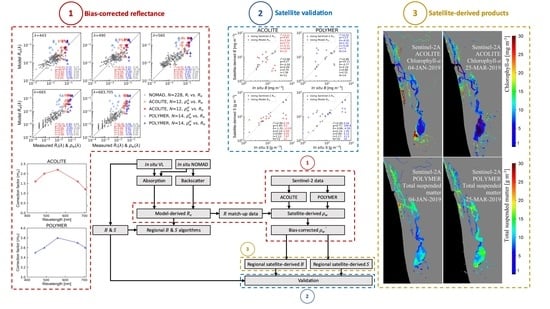Regional Satellite Algorithms to Estimate Chlorophyll-a and Total Suspended Matter Concentrations in Vembanad Lake
Abstract
Share and Cite
Theenathayalan, V.; Sathyendranath, S.; Kulk, G.; Menon, N.; George, G.; Abdulaziz, A.; Selmes, N.; Brewin, R.J.W.; Rajendran, A.; Xavier, S.; et al. Regional Satellite Algorithms to Estimate Chlorophyll-a and Total Suspended Matter Concentrations in Vembanad Lake. Remote Sens. 2022, 14, 6404. https://doi.org/10.3390/rs14246404
Theenathayalan V, Sathyendranath S, Kulk G, Menon N, George G, Abdulaziz A, Selmes N, Brewin RJW, Rajendran A, Xavier S, et al. Regional Satellite Algorithms to Estimate Chlorophyll-a and Total Suspended Matter Concentrations in Vembanad Lake. Remote Sensing. 2022; 14(24):6404. https://doi.org/10.3390/rs14246404
Chicago/Turabian StyleTheenathayalan, Varunan, Shubha Sathyendranath, Gemma Kulk, Nandini Menon, Grinson George, Anas Abdulaziz, Nick Selmes, Robert J. W. Brewin, Anju Rajendran, Sara Xavier, and et al. 2022. "Regional Satellite Algorithms to Estimate Chlorophyll-a and Total Suspended Matter Concentrations in Vembanad Lake" Remote Sensing 14, no. 24: 6404. https://doi.org/10.3390/rs14246404
APA StyleTheenathayalan, V., Sathyendranath, S., Kulk, G., Menon, N., George, G., Abdulaziz, A., Selmes, N., Brewin, R. J. W., Rajendran, A., Xavier, S., & Platt, T. (2022). Regional Satellite Algorithms to Estimate Chlorophyll-a and Total Suspended Matter Concentrations in Vembanad Lake. Remote Sensing, 14(24), 6404. https://doi.org/10.3390/rs14246404












